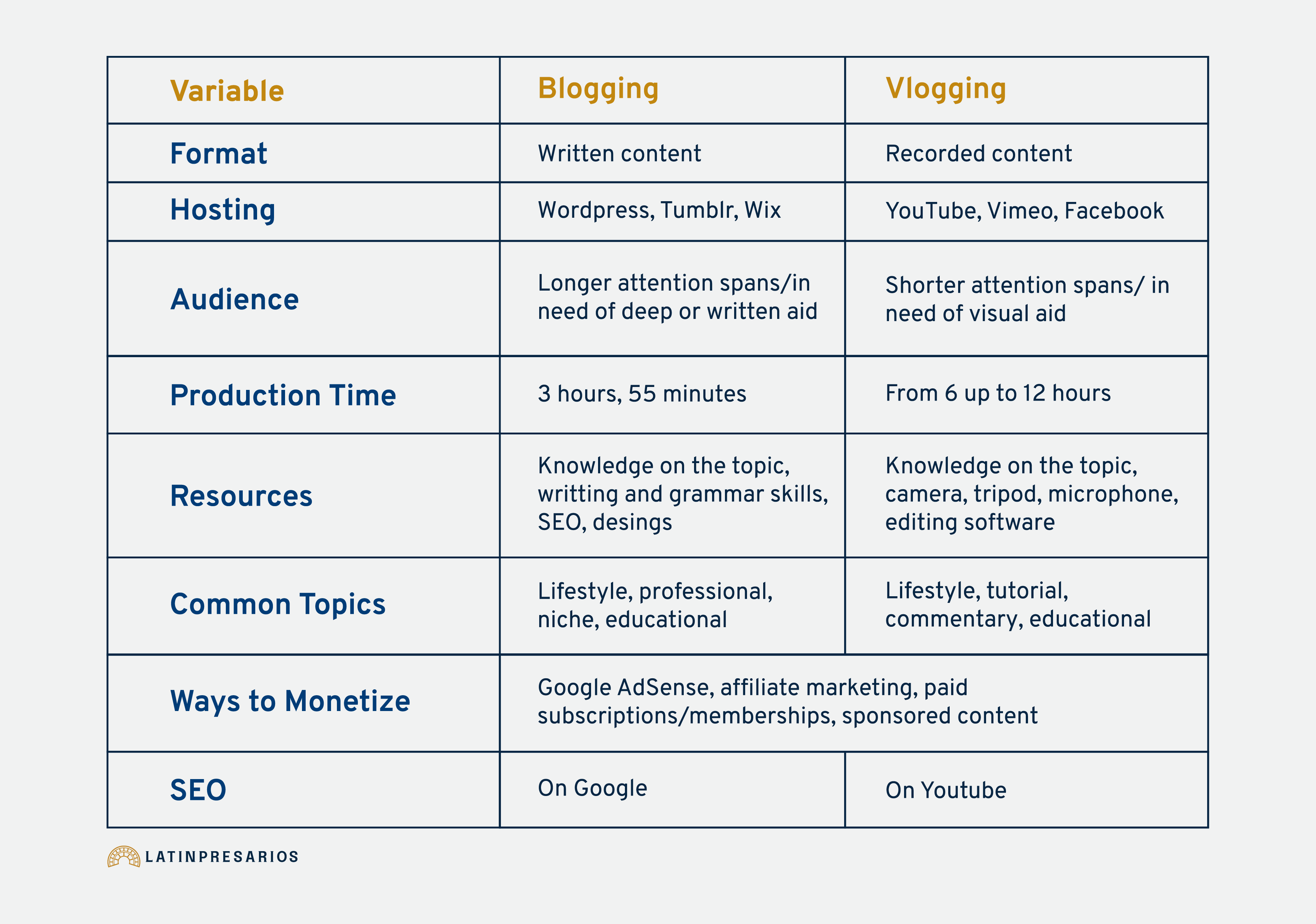Content marketing gets more and more important over time.
Companies, small businesses, influencers, and even solopreneurs are understanding the role content plays in getting new leads and closing deals.
According to Hubspot, videos and blogs were the two primary forms of media used in content marketing during 2021.
As a marketer or a small company owner, you might be wondering what are the key differences between blogging vs. vlogging.
The main difference: blogs are written pieces of content, generally uploaded to websites, and vlogs are videos, usually found on video platforms.
Which one is better? Written or recorded? Which will make you more money? Which costs more?
The short answer is that the best option will depend on your particular budget and goals.
Contents
Is Blogging Dead?
Many people think and say that blogging is dead.
With the rise of video formats such as TikToks, Reels, or YouTube Shorts, it’s easy to think that not as many people read blogs anymore.
However, producing written content and uploading it to your website is still a key step in positioning your business in search engines and building brand authority.
77% of internet users still read blogs, according to LinkedIn, and to this day, users leave more than 77 million comments each month using WordPress alone.
Blogging is not the same as it was 20, 10, or even 3 years ago. This doesn’t mean that it’s not still relevant and important to incorporate into your strategy.
Similar things happen to vlogs. They used to be longer, with creators sharing 30 or 40-minute-long videos of their routines and activities.
Nowadays, it is recommended that vloggers make 5-15 minute videos (or less!) to successfully capture users’ attention.
It’s all about understanding how the market and the audience change and adapting your content without modifying your essence.
In this blog, you will find 7 variables to take into account when researching blogging vs. vlogging and deciding which one is the best for you.
Format & Hosting
As we explained before, the main and most obvious difference between blogging vs. vlogging is the format.
Blogs are written pieces of content, uploaded to a website. They can also have pictures, infographics, and even videos.
The average blog is between 1,500 and 2,000 words long.
A vlog is a shortened term for “video log”, and consists of a video, uploaded to a video platform.
The average vlog is about 11 minutes.
If you have a website, you can upload blogs and vlogs. However, this is not as common. Usually, websites are made of mainly written content, and vlogs exist on other types of platforms.
When creating a website, you can check out systems such as WordPress, Tumblr, or Wix. These will allow you to customize your site, create posts whenever you want, etc.
When looking for where to upload your vlogs, you can create an account on Vimeo, Facebook, or other platforms. Nonetheless, we recommend YouTube, since it is one of the most used platforms on the Internet and it also works as a search engine.
Audiences
Even if you are talking about the same topic in blogs and vlogs, chances are that the audience you reach is different.
Usually, blogs take a longer time to consume. This attracts “serious” readers or people that have a higher compromise with the content they are consuming.
It’s also the preferred format when the information you are providing should be kept written. For example a list of the best sellers of X products in your zone, a particular tutorial for a long process, etc.
On the other hand, vlogs tend to be shorter and offer faster answers. Since our attention spans and shortening, videos are an easier way to access information.
Vlogs are also especially useful when some sort of visual aid is required (a tutorial on how to build something, or a travel vlog).
Production Time
A very important variable to consider when researching blogging vs. vlogging is how much time you will invest in each content piece.
According to Orbit Media, an average blog takes 3 hours and 55 minutes to be written.
This time is not considering other factors such as keyword research, making designs, uploading, or updating the blog.
Estimating how long it takes to produce a video can be trickier. For a “simple” vlog, one could estimate 1-2 hours of pre-production, 2-4 hours of filming, and 3-6 hours of editing. This gives us a range from 6 up to 12 hours per video.
But if you’re aiming for a professional look, investing in high-quality video production services can be a game changer. Actually, a lot of businesses and content creators will go this route (maybe not always but for major content at least).
So, why this?
Well, these experts can handle everything from filming to editing, ensuring your vlog stands out with polished visuals and seamless storytelling, meaning, it leaves you free to focus on your content.
In either case, the time will vary depending on your expertise and the specific topic you address in each piece. But in today’s era AI plays a major role to reduce time with the help of free AI video editor.
Nevertheless, in general, video content takes longer, since it requires a lot of previous and further work with the raw material.
Resources
To produce content, you will need resources.
I’m not talking about monetary resources (even though they will eventually be required), but all kinds of materials.
To make a good blog on any topic, you will need at least:
- Expertise on the subject you’re addressing: no matter how simple or specialized your content is, you must know what you’re writing about to provide users with valuable information.
- Writing and grammar skills: you have to be very clear when writing a blog to effectively communicate your ideas.
- Basic SEO knowledge: if you want your blogs to rank and be found, you need to understand the basics of search engines and how to know what to write about.
- Designer skills: a blog without additional content is boring. Articles that include visuals get 94% more views than those without (B2B Marketing). You should know a bit about design or hire a designer to make some content for your blogs.
If you’re rather thinking about vlogging, you will need other types of resources:
- Expertise: for the same reasons earlier addressed.
- Camera: you can use your phone camera, but if you’re taking vlogging seriously, a semi-professional camera can go from $700 up to $5,000.
- Microphone: the mic your phone or camera comes with will not be enough. They range from $30 to $600 or more.
- Tripod: you can find good tripods for $20, or invest in a professional one for $200 or more.
- Editing software: some free options are Blender, Lightworks, or Da Vinci Resolve. Other paid software is Adobe Premiere or Final Cut X.
Common Topics
The topics you will find in blogging vs. vlogging won’t be that different from one another.
However, the way they address each topic and how creators present it will be.
Blogs usually belong to one of the following categories:
- Lifestyle: they tend to be focused on a particular kind of life. You can find blogs about mother or fatherhood, traveling, fitness, etc.
- Professional: if you are a professional in a certain industry, a great way to build a personal brand is by running a professional or business blog in which you write about your struggles, successes, anecdotes, etc.
- Niche: when you write content for a specific group of people (ex. science fiction movie fans, corgi owners, gardening, etc).
- Educational: you can turn into a reliable source in an area of your expertise by writing content. This can also be done as a strategy to grow your audience.
As you can see, these categories can overlap each other or be combined.
You can find very similar categories when it comes to vlogging. However, vlogs can also vary depending on different formats for individual videos.
- Lifestyle: a lifestyle kind of vlog can focus on following the creator through their routine, a particular activity, a trip, etc.
- Tutorials: video tutorials are very visited since they are so easy to consume and provide quick answers.
- Commentary: you can get very creative with this type of video. You can talk about a certain topic you know a lot about, review products, etc.
- Educational: These kinds of vlogs seek to inform people in the most neutral way possible and offer facts about the topic.
Ways to Monetize
There are many ways to make money with online content.
The following can be used for blogs or vlogs. Their essence will be the same, but the execution can change a little bit according to the format.
Google AdSense
This is Google’s system that shows paid ads before, during, or after your content.
If you have a website, you can add a definite space for them to show up. If you’re vlogging on YouTube, you will have to activate it.
Either way, you will get paid depending on how many visits you can get.
Affiliate marketing
This is a marketing strategy that allows creators to earn commissions depending on how many people buy a certain product thanks to their recommendation.
Usually, the companies will give creators a discount code to offer their followers.
To be successful at affiliate marketing, you must have a network/audience that already trusts you, or they won’t buy for you.
The products you promote should also be focused on your audience’s likes and needs, and match your blog’s topics.
Remember that with this system, you will only get paid depending on the number of impressions, clicks, or sales you help the company achieve.
Paid Subscriptions / Memberships
YouTube, Twitter, Patreon, and other platforms, are offering ways to subscribe to your favorite creators and access premium content.
This is especially relevant for tutors, advisors, or creators with educational purposes.
With this strategy, you would be getting paid to offer your content.
However, this of course requires a medium-to-large audience that already trusts you and wants to learn more from you.
Sponsored Content
Sponsored content seeks to increase brand awareness and reach particular audiences.
When you have a certain number of visitors, you can get in contact with brands of your interest and get to a sponsor agreement by mentioning the brand at some point in your blog or vlog.
This can feel similar to affiliate marketing, but it is not the same.
A sponsor will pay you beforehand for the space in your content. Affiliate, as we explained before, will pay you depending on the results.
Paid Reviews
Paid reviews and sponsored content can be very similar, depending on the company and the particular agreement.
Usually, paid reviews can be a one-time thing, while sponsored content can involve a longer and more complex strategy.
It is when a business sends you a certain product for you to try and then review, either in a written or recorded format.
Depending on your niche, these products can be software, video games, makeup, food, specialized equipment, etc.
Search Engine Optimization
The last variable we will be studying in this article is search engine optimization.
You probably think SEO will only work for blogs on websites.
And while Google is the biggest search engine on the Internet and it focuses on written content, YouTube also works as a search engine of its own.
This is why we recommend using YouTube if you’re vlogging. It will allow you to effectively tag your content and optimize it to find the right audience.
You can use the UberSuggest Google Chrome extension to track keywords and find trends to classify your content.
Understanding Blogging vs. Vlogging

You can talk about the same topics in blogs or vlogs.
However, the format and strategy will vary, and therefore, the audience you will reach will be different too.
You don’t have to choose and stick to only one: you can combine both and maximize results.
As a business owner, you must know how to use your resources and still get the most out of them.
That’s why it is so important to understand the distinctions between blogging vs. vlogging.
If you are interested in pursuing video making, you can read our YouTube guide.
If you think blogging is your thing, we also have a Blogging guide.
We know that content creation is no easy task. Check our content marketing plans without compromise.





